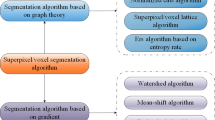Abstract
Supervoxel segmentation has become an essential tool to medical image analysis for three-dimension MR image. However, in no consideration of the intensity inhomogeneity in 2D/3D MR image, the state-of-the-art supervoxel segmentation methods do not satisfy the further analysis, such as tissue classification according to intensity feature. In order to overcome the above-mentioned issues, we propose a modified supervoxel segmentation method for three-dimension MR image, which integrates the bias field into the weighted distance metric to determine the nearest cluster center. The supervoxel segmentation and bias correction can be simultaneously completed in our method. Especially, the bias corrected image lays the foundation for the supervoxel classification in accordance with the intensity feature. The experimental results and quantitative evaluation showed that the supervoxels obtained by our method are adherence to the MR tissue boundaries, and the bias corrected image is positive for the intensity feature extraction.











Similar content being viewed by others
References
Kirchhoff BA, Gordon BA, Head D (2014) Prefrontal gray matter volume mediates age effects on memory strategies. Neuroimage 90(8):326–334
Su P, Yang J, Li H et al (2013) Superpixel-based segmentation of glioblastoma multiforme from multimodal mr images[M]. Multimodal Brain Image Anal 8159:74–83
Ren X, Malik J (2003) Learning a Classification Model for Segmentation[C]. In: Proceedings of IEEE international conference on computer vision. IEEE, 2008, vol 1. pp 10–17
Lucchi A, Smith K, Achanta R et al (2012) Supervoxel-based segmentation of mitochondria in em image stacks with learned shape features. IEEE Trans Med Imaging 31(2):474–486
Kong Y, Deng Y, Dai Q (2015) Discriminative clustering and feature selection for brain MRI segmentation. IEEE Signal Process Lett 22(5):573–577
Verma N, Cowperthwaite MC, Markey MK (2013) Superpixels in brain MR image analysis. Conf Proc IEEE Eng Med Biol Soc 2013:1077–1080
Achanta R, Shaji A, Smith K et al (2012) SLIC superpixels compared to state-of-the-art superpixel methods. IEEE Trans Pattern Anal Mach Intell 34(11):2274–2282
Tian Z, Liu L Z, Fei B (2015) A supervoxel-based segmentation method for prostate MR images[C]. In: SPIE medical imaging. International society for optics and photonics
Greenspan H, Ruf A, Goldberger J (2006) Constrained Gaussian mixture model framework for automatic segmentation of MR brain images. IEEE Trans Med Imaging 25(9):1233–1245
Achanta R, Shaji A, Smith K et al (2010) Slic superpixels[R]
Van Leemput K, Maes F, Vandermeulen D et al (1999) Automated model-based bias field correction of MR images of the brain. IEEE Trans Med Imaging 18(10):885
Xiong H, Gao J, Zhu C et al (2014) An interleaved otsu segmentation for MR images with intensity inhomogeneity. Ieice Trans Inf Syst 97(11):2974–2978
Li C, Gore JC, Davatzikos C (2014) Multiplicative intrinsic component optimization (MICO) for MRI bias field estimation and tissue segmentation. Magn Reson Imaging 32(7):913–923
Li C, Xu C, Anderson A W, et al (2009) MRI tissue classification and bias field estimation based on coherent local intensity clustering: a unified energy minimization framework[C]. In: International conference on information processing in medical imaging. Springer, Berlin, pp 288–299
Achanta R, Shaji A, Smith K et al (2010) SLIC superpixels. EDFL Technical Report no. 149300, June 2010
Yu J, Yang X, Gao F, et al (2016) Deep multimodal distance metric learning using click constraints for image ranking. IEEE Trans Cybern
Li C, Gatenby C, Wang L, et al (2009) A robust parametric method for bias field estimation and segmentation of MR images[C]. In: IEEE conference on computer vision and pattern recognition, CVPR 2009. IEEE Xplore 2009, pp 218–223
Gao J, Li C, Feng C et al (2014) Non-locally regularized segmentation of multiple sclerosis lesion from multi-channel MRI data. Magn Reson Imaging 32(8):1058–1066
Xie M, Gao J, Zhu C et al (2015) A modified method for MRF segmentation and bias correction of MR image with intensity inhomogeneity. Med Biol Eng Comput 53(1):23–35
Cocosco CA, Kollokian V, Kwan KS et al (1997) BrainWeb: online Interface to a 3D MRI simulated brain database. Neuroimage 5:425
Macqueen J (1967) Some methods for classification and analysis of multivariate observations[C]. In: Proceedings of berkeley symposium on mathematical statistics and probability, pp 281–297
Shattuck DW, Sandor-Leahy SR, Schaper KA et al (2001) Magnetic resonance image tissue classification using a partial volume model. NeuroImage 13(5):856–876
Ashburner J, Friston KJ (2005) Unified segmentation. Neuroimage 26(3):839–851
Pham DL (2001) Robust fuzzy segmentation of magnetic resonance images[C]. In: Fourteenth IEEE symposium on computer-based medical systems. IEEE Computer Society, p 127
Friston KJ (2013) Statistical parametric mapping: the analysis of functional brain images. Neurosurgery 61(1):216–216
Acknowledgements
This work was supported by National Natural Science Foundation of China (NSFC) via grant 61401473, 61701078. The authors thank Dr. Youyong Kong for his help with running SLIC method.
Author information
Authors and Affiliations
Corresponding author
Rights and permissions
About this article
Cite this article
Gao, J., Dai, X., Zhu, C. et al. Supervoxel Segmentation and Bias Correction of MR Image with Intensity Inhomogeneity. Neural Process Lett 48, 153–166 (2018). https://doi.org/10.1007/s11063-017-9704-5
Published:
Issue Date:
DOI: https://doi.org/10.1007/s11063-017-9704-5




